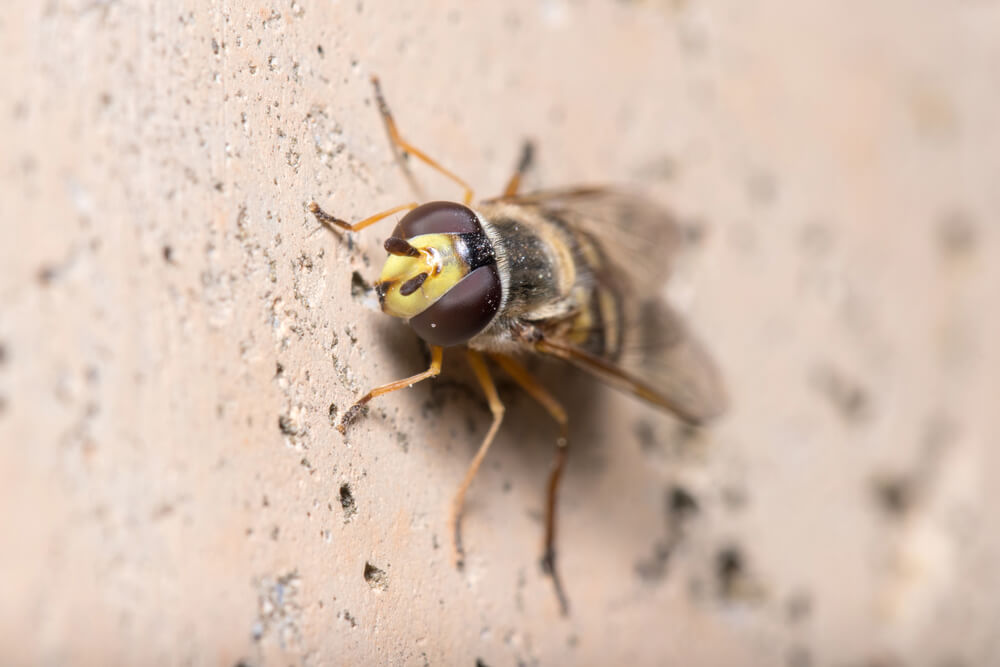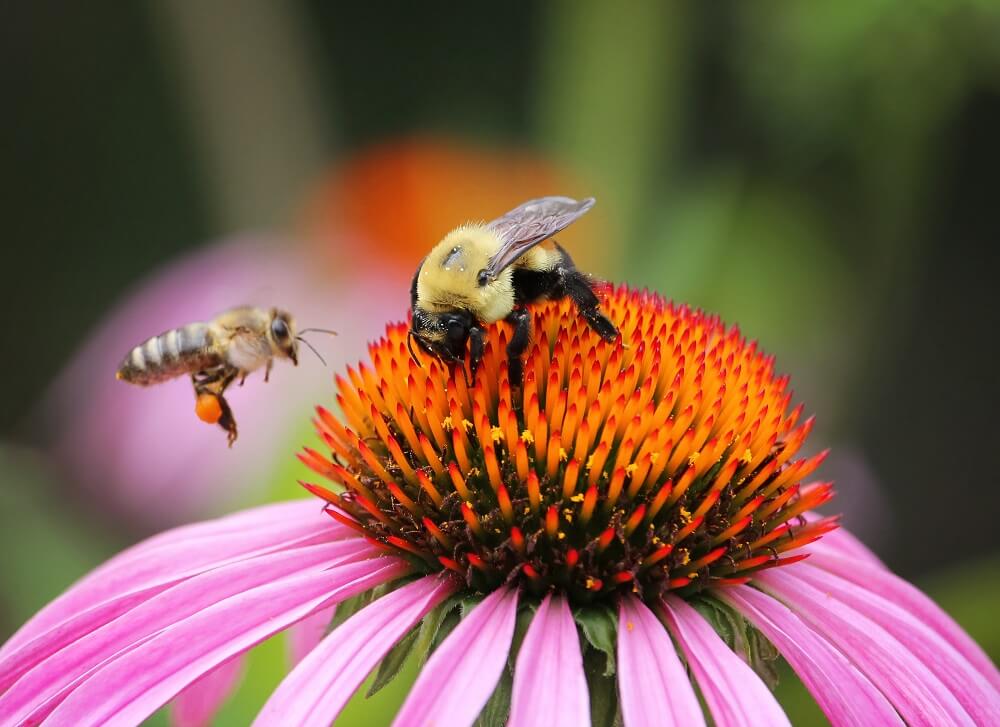What’s the Difference Between Honey Bees and Mason Bees?
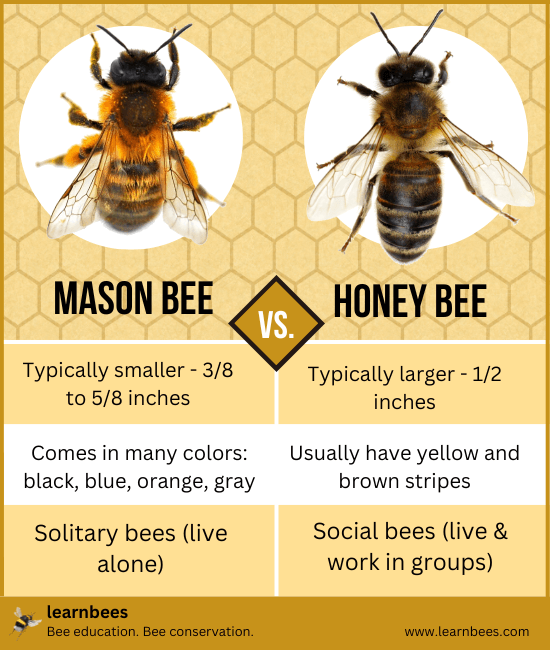
Mason bees and honey bees are two different bee species. They have unique nesting and lifestyle habits, but these beneficial pollinators also have many similarities.
In this article, we’ll discuss the following characteristics between mason bees and honey bees:
- Stinging Abilities
- Honey Production
- Pollination
- Nesting Habits
- Location Found
- Physical Appearance
- Lifespan
Mason Bee vs. Honey Bee: Stinging
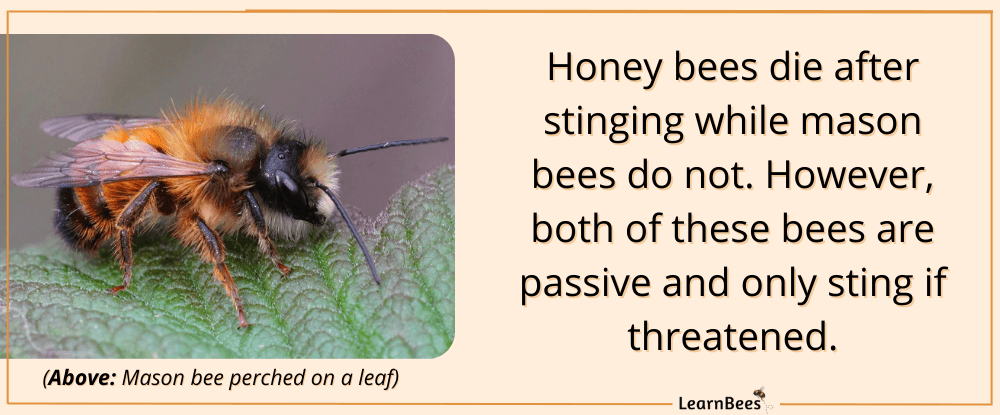
Both mason bees and honey bees can sting.
However, only female bees can sting. Male bees cannot.
Male bees live short lives because their sole purpose is to mate. They don’t have nesting duties that require longer lifespans like female bees. Additionally, female bees use their stingers to defend their nest, a responsibility male bees don’t typically have.
With that said, the likelihood of getting stung by a mason bee or honey bee is low. Bees often have to be directly threatened near their nest in order to sting.
Despite popular belief:
Bees aren’t aggressive, mean insects that are out to hurt people.
That’s right. Bees actually don’t want to sting you. Instead, they want to keep themselves busy nesting and foraging on flowers. Many bees often work from sun up to sun down, earning them the title of “busy bees.”
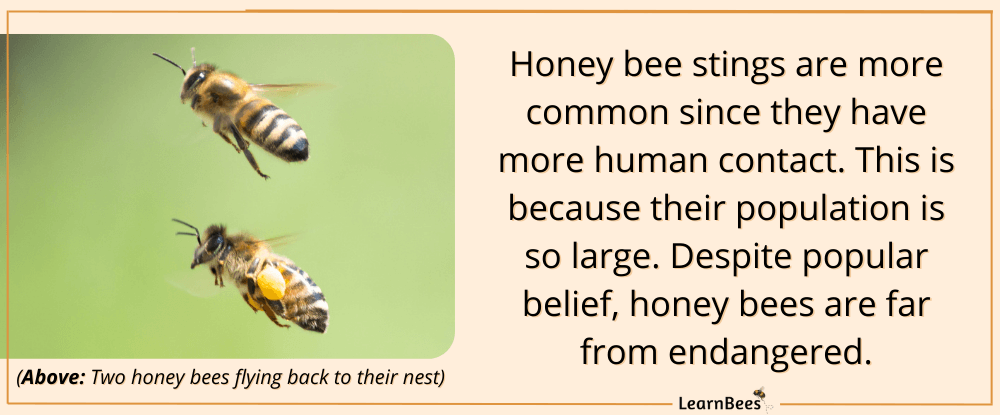
With that said, honey bee stings are more common than mason bee stings for a few reasons:
- Honey bee populations are incredibly high, which increases the likelihood of human interaction. Honey bees are far from endangered. In fact, it’s estimated that there are more honey bees on earth now than ever in human history – mainly because of beekeepers.(1, 2)
- Honey bees produce honey that predators target them for. Bears, honey badgers, and other animals love the taste of honey. As a result, honey bees are naturally more territorial since they’re easy targets.
- Honey bees have a queen bee, which they aim to protect. Without the queen bee, the colony will not survive, so honey bees are very protective of their queen.
Here’s a stinging fact that might surprise you:
Honey bees are the only known bees that die after stinging. Mason bees and other bee species can sting without dying as many times as necessary to defend themselves.
Honey bees die after stinging because they lose their stinger. The stinger, which is barbed like a hook, gets lodged in our skin and is pulled out of the honey bee as it flies away.
Unfortunately, a honey bee sting is fatal because the stinger is attached to vital organs. The honey bee needs its stinger for its internal organs to stay intact.
Mason Bee vs. Honey Bee: Honey Production
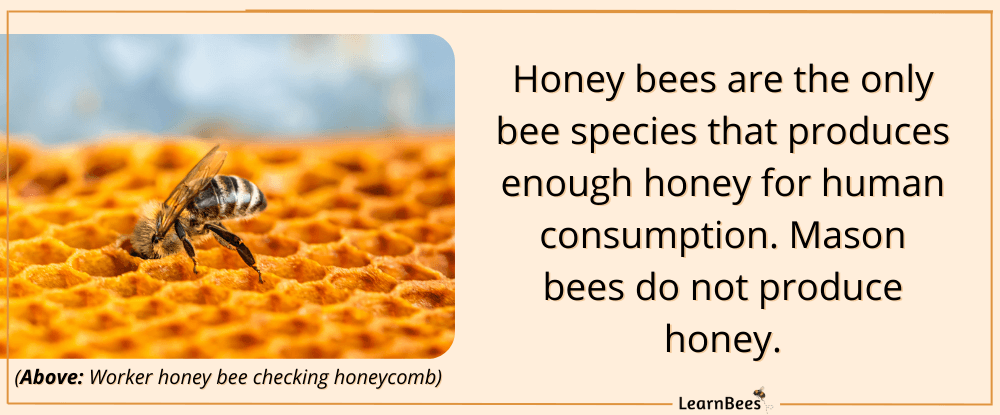
As their name suggests, honey bees produce large amounts of honey. In contrast, mason bees don’t make any honey.
Why?
Honey bees need honey for food, while mason bees do not. You see, honey bee colonies survive the winter months by clustering together to stay warm. They use their stored honey as food since there are few to no flowers in the winter.
Mason bees are different.
Mason bees don’t produce honey because they aren’t active during the winter like honey bees are. Instead, mason bees hibernate until the weather warms up.
Once spring arrives, both mason bees and honey bees forage on flowers for pollen and nectar. Pollen is a protein source, and nectar is a carbohydrate source for bees.
Honey bees know they’ll need plenty of honey for winter storage and they need to make excess honey just to be on the safe side. Honey bees are the only species of bee that produces enough honey for human consumption.
Bumble bees produce honey, too; however, they don’t make nearly as much as honey bees.
Mason Bee vs. Honey Bee: Pollination
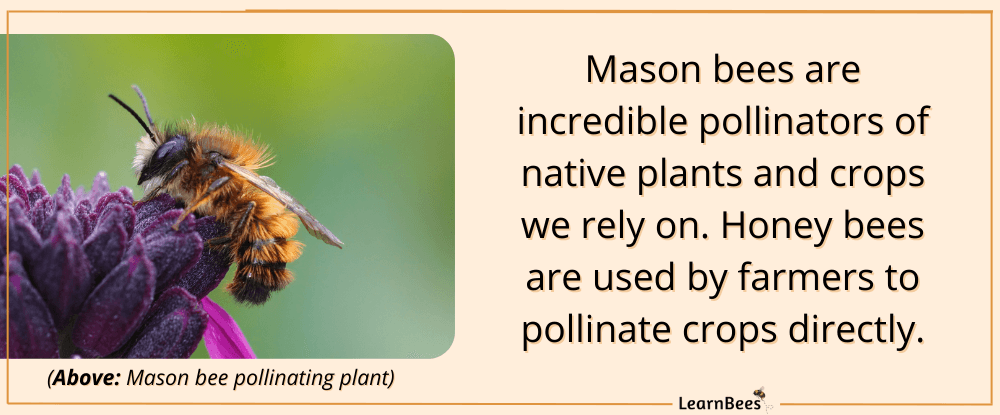
Mason bees and honey bees are both valuable pollinators in different ways.
For one, mason bees are native to the United States, so they’re prolific pollinators of native plants. Mason bees do an incredible job of pollinating early-blooming fruit trees like pears, plums, cherries, and apples. This earns some mason bee species the nickname of “orchard bees.”(3)
Native bees like mason bees, carpenter bees, and leafcutter bees are the unsung heroes of the insect world. In short, we need these native bees in our ecosystems.
Honey bees are valuable pollinators in a different way.
Farmers rent honey bee hives from beekeepers to pollinate their crops. Honey bees can have large colonies of 50,000 or more bees. The sheer size of a honey bee colony allows them to pollinate many crops.
Mason Bee vs. Honey Bee: Nesting Habits
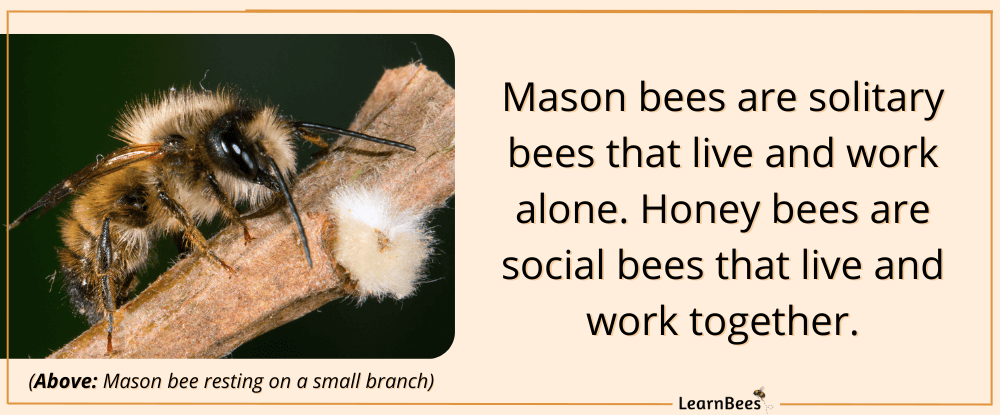
Mason bees are solitary bees that live alone. The female bee creates her nests and lays eggs. She is solely responsible for collecting food and defending her nest.
Honey bees, on the other hand, are social bees that live in colonies. A honey bee colony comprises a queen, thousands of worker bees (female), and a few hundred drones (male).
Honey bee colonies work together like a well-oiled machine to collect food, produce honey, defend the nest, and raise their young.
Wild honey bees typically nest high up in trees to deter ground predators like skunks. They use beeswax to build honeycomb and brood combs to raise their young.
Wild mason bees nest in holes inside of trees or or irregular cavities under rock and bark. Some mason bee species dig their nests in the ground.
Mason Bee vs. Honey Bee: Location Found
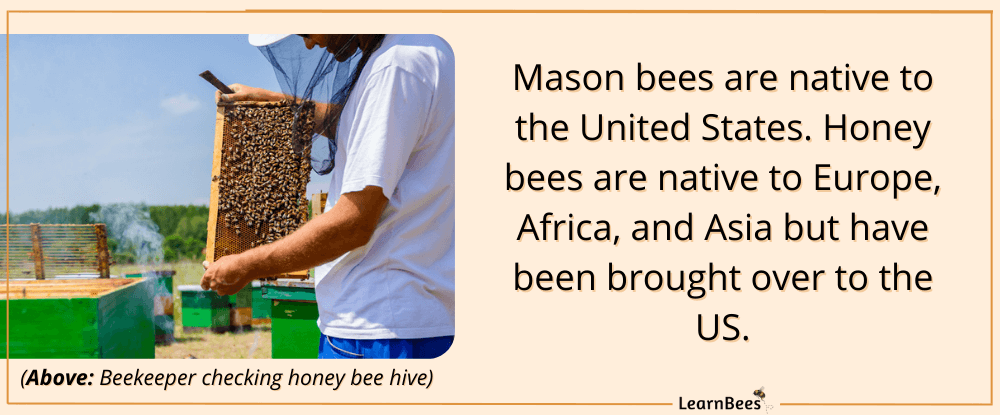
There are about 140 species of mason bees native to the United States.(3, 4)
Honey bees aren’t native to the United States. However, early settlers brought them to this country, and their population has grown considerably.
Unfortunately, the rise in non-native insects like honey bees, hornets, and others – leads to a decline in valuable native insects like bumble bees, mason bees, and more.
This is why it’s absolutely critical to plant things native to your particular area. Native insects rely on native plants for food and shelter. Non-native flowers and plants are often invasive and useless to our native bees, butterflies, and insect species.
For more information on helping native pollinators, watch Doug Tallamy’s presentation on how you can make a difference.
Mason Bee vs. Honey Bee: Physical Appearance
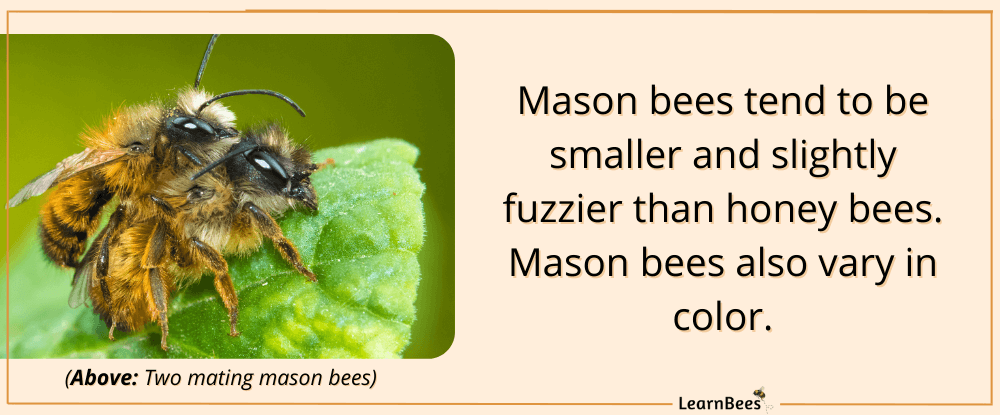
Remember that there are over 140 species of mason bees in the US and eight species of honey bees. With that in mind, each species can have slight variations in size, color, shape, and body hair.
For example, some mason bee species have a slight blue coloring. These are often called blue orchard mason bees (Osmia lignaria).
Other species of mason bees appear black or dark gray. It really just depends on the species. People may also mistake mason bees for other species, like leafcutter bees, which are, in fact, a different type of bee.
Honey bees are easier to identify thanks to their yellow and brown stripes. Additionally, honey bees are social bees that pollinate in groups. So, if you see one honey bee, you’ll likely see dozens more around the same plant.
On average, honey bees are usually slightly larger than mason bees – measuring about 1/2 inch long. Mason bees can be anywhere from 3/8 to 1/2 inch, depending on the species.(5, 6)
Mason Bee vs. Honey Bee: Lifespan
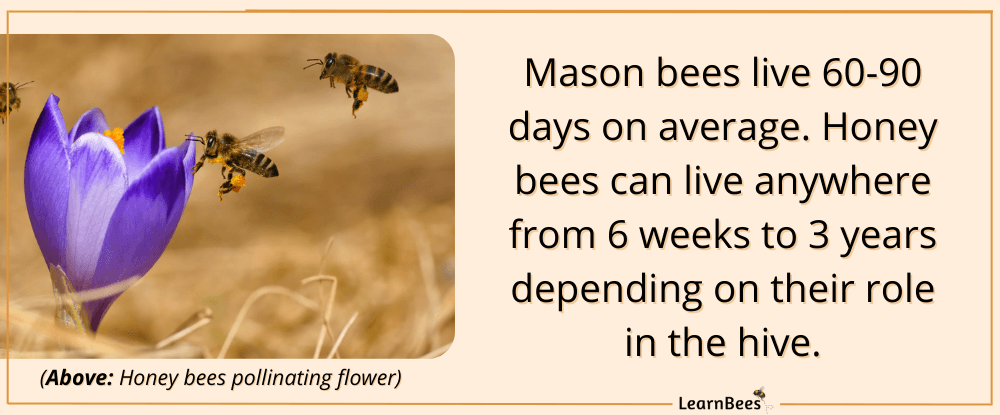
Female mason bees live for about one month and lay one to two eggs per day. Male mason bees have shorter lives, living only just a few weeks since their only purpose is to mate.
The lifespan of honey bees depends on their role inside the colony.
Queen honey bees live the longest – with an average lifespan of two to three years. Worker honey bees live anywhere from six weeks to six months, depending on their birth season.
Male honey bees live no more than 90 days. They die immediately after mating.
Do Mason Bees and Honey Bees Get Along?

A common question we get asked is, “Can mason bees and honey bees coexist?”
The answer is yes: Honey bees and mason bees coexist peacefully together. As mentioned, bees are gentle creatures that spend most of their time working. Bees also don’t eat other insects like wasps and hornets do.
Bees rely solely on flowers for food, which explains why they spend so much time foraging for pollen and nectar. Bees typically only enter “defense mode” when they or their nest are threatened.
In fact, most bees will fly away if you try to touch them while they’re on flowers. Some bees, like sweat bees, are so skittish that they’ll fly away before you can even get near them.
Honey bees, bumble bees, and carpenter bees are less shy. This is why it’s not uncommon for gardeners to work alongside such bees outside. The bees respect their space and vice versa.
In short, mason bees and honey bees coexist peacefully with other insects, such as butterflies, ladybugs, and moths.
FAQs about Mason Bees Versus Honey Bees
- Can mason bees sting you like honey bees?
- Can mason bees make honey?
- Where do mason bees live?
- What do mason bees eat?
Can mason bees sting you like honey bees?
Yes, mason bees can sting like honey bees. But, mason bees are more likely to fly away from danger since they don’t have a large nest to protect like honey bees. Also, only female bees can sting.
—> Go back to the FAQs on mason bees versus honey bees
More to Explore:
Can mason bees make honey like honey bees?
No, mason bees cannot make honey.
—> Go back to the FAQs on mason bees versus honey bees
More to Explore:
- What Are Blue Orchard Bees?
- The Fascinating Life of Queen Bees
- Queen Bee Versus Worker Bees – How Do They Compare?
Where do mason bees live?
Mason bees are found worldwide, including in North America, Europe, Asia, and Africa.
—> Go back to the FAQs on mason bees versus honey bees
More to Explore:
What do mason bees eat?
Mason bees eat nectar and pollen from flowers.


